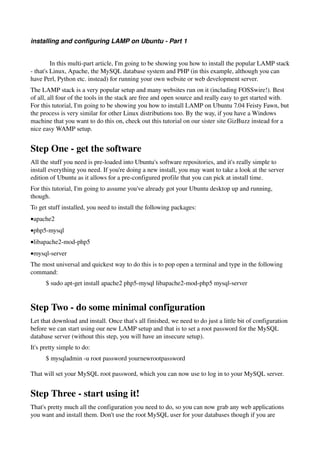configure website lamp stack in ubuntu output
•Download as DOC, PDF•
0 likes•229 views
Report
Share
Report
Share

Recommended
Recommended
More Related Content
Featured
Featured (20)
Product Design Trends in 2024 | Teenage Engineerings

Product Design Trends in 2024 | Teenage Engineerings
How Race, Age and Gender Shape Attitudes Towards Mental Health

How Race, Age and Gender Shape Attitudes Towards Mental Health
AI Trends in Creative Operations 2024 by Artwork Flow.pdf

AI Trends in Creative Operations 2024 by Artwork Flow.pdf
Content Methodology: A Best Practices Report (Webinar)

Content Methodology: A Best Practices Report (Webinar)
How to Prepare For a Successful Job Search for 2024

How to Prepare For a Successful Job Search for 2024
Social Media Marketing Trends 2024 // The Global Indie Insights

Social Media Marketing Trends 2024 // The Global Indie Insights
Trends In Paid Search: Navigating The Digital Landscape In 2024

Trends In Paid Search: Navigating The Digital Landscape In 2024
5 Public speaking tips from TED - Visualized summary

5 Public speaking tips from TED - Visualized summary
Google's Just Not That Into You: Understanding Core Updates & Search Intent

Google's Just Not That Into You: Understanding Core Updates & Search Intent
The six step guide to practical project management

The six step guide to practical project management
Beginners Guide to TikTok for Search - Rachel Pearson - We are Tilt __ Bright...

Beginners Guide to TikTok for Search - Rachel Pearson - We are Tilt __ Bright...
configure website lamp stack in ubuntu output
- 1. installing and configuring LAMP on Ubuntu Part 1 In this multipart article, I'm going to be showing you how to install the popular LAMP stack that's Linux, Apache, the MySQL database system and PHP (in this example, although you can have Perl, Python etc. instead) for running your own website or web development server. The LAMP stack is a very popular setup and many websites run on it (including FOSSwire!). Best of all, all four of the tools in the stack are free and open source and really easy to get started with. For this tutorial, I'm going to be showing you how to install LAMP on Ubuntu 7.04 Feisty Fawn, but the process is very similar for other Linux distributions too. By the way, if you have a Windows machine that you want to do this on, check out this tutorial on our sister site GizBuzz instead for a nice easy WAMP setup. Step One get the software All the stuff you need is preloaded into Ubuntu's software repositories, and it's really simple to install everything you need. If you're doing a new install, you may want to take a look at the server edition of Ubuntu as it allows for a preconfigured profile that you can pick at install time. For this tutorial, I'm going to assume you've already got your Ubuntu desktop up and running, though. To get stuff installed, you need to install the following packages: •apache2 •php5mysql •libapache2modphp5 •mysqlserver The most universal and quickest way to do this is to pop open a terminal and type in the following command: $ sudo aptget install apache2 php5mysql libapache2modphp5 mysqlserver Step Two do some minimal configuration Let that download and install. Once that's all finished, we need to do just a little bit of configuration before we can start using our new LAMP setup and that is to set a root password for the MySQL database server (without this step, you will have an insecure setup). It's pretty simple to do: $ mysqladmin u root password yournewrootpassword That will set your MySQL root password, which you can now use to log in to your MySQL server. Step Three start using it! That's pretty much all the configuration you need to do, so you can now grab any web applications you want and install them. Don't use the root MySQL user for your databases though if you are
- 2. working in an environment where you need things to be secure. Set up a user and database for each application you install (you can use something like PHPMyAdmin for this). In the next part of this tutorial, I'll be looking at some awesome tweaks you can make to your LAMP setup and how to easily install some of the most popular web applications. Tips and tricks To start and stop the servers independently of rebooting (for example after changing configuration files, you can use these commands): Apache and PHP $ sudo /etc/init.d/apache2 restart Replace 'restart' with either 'start' or 'stop', as needed. MySQL $ sudo /etc/init.d/mysql restart